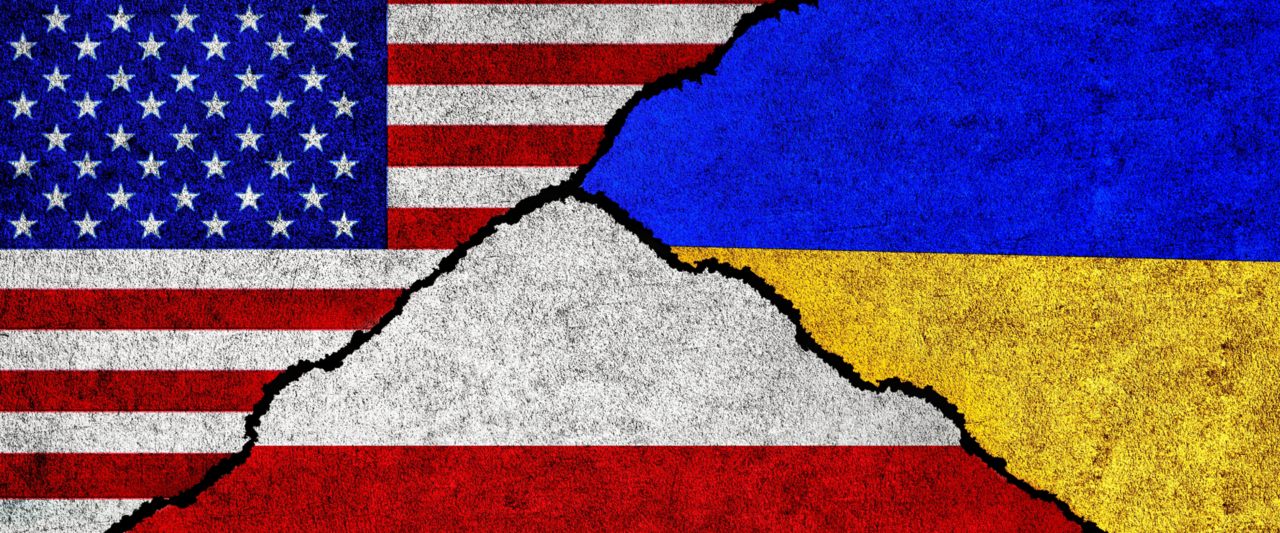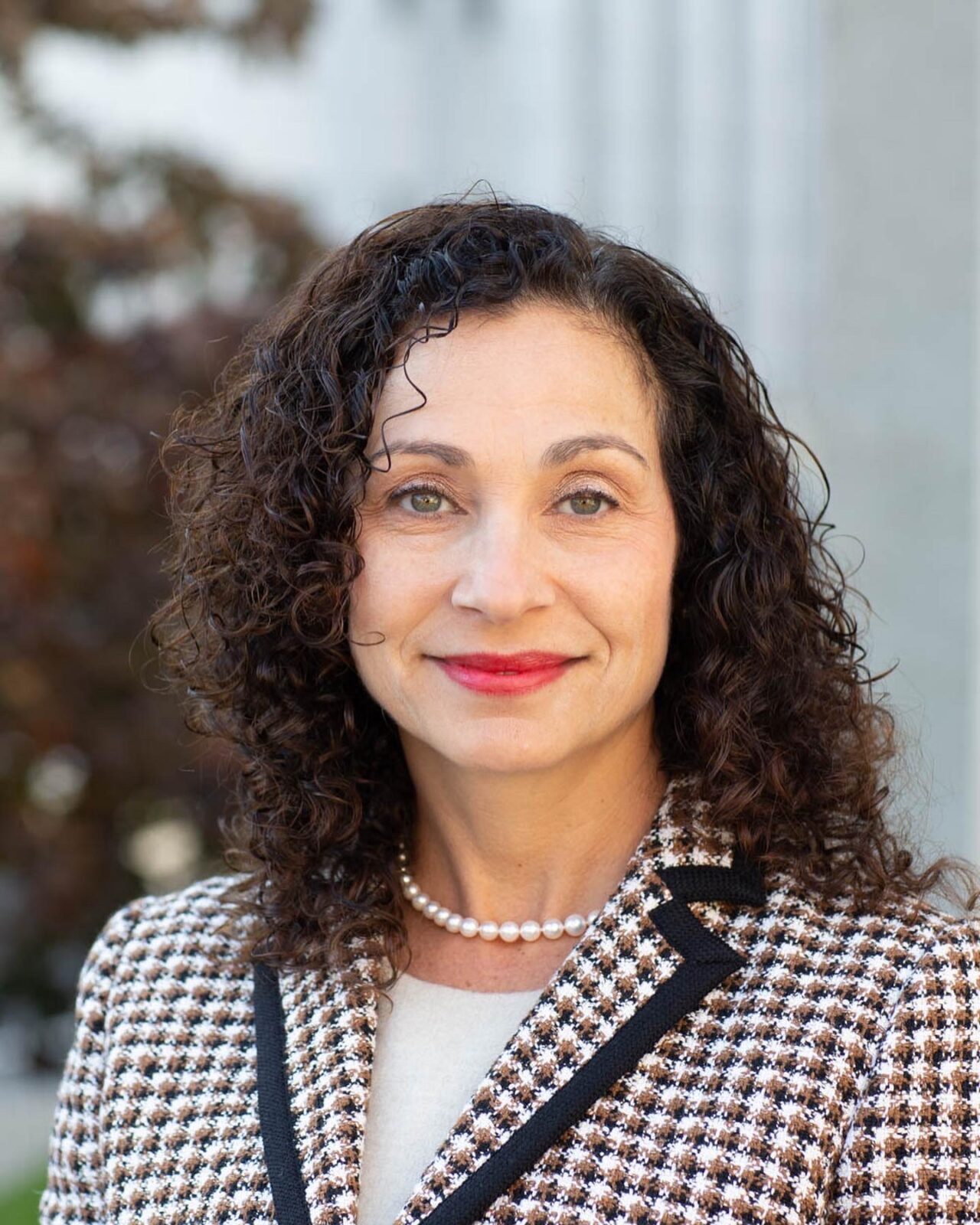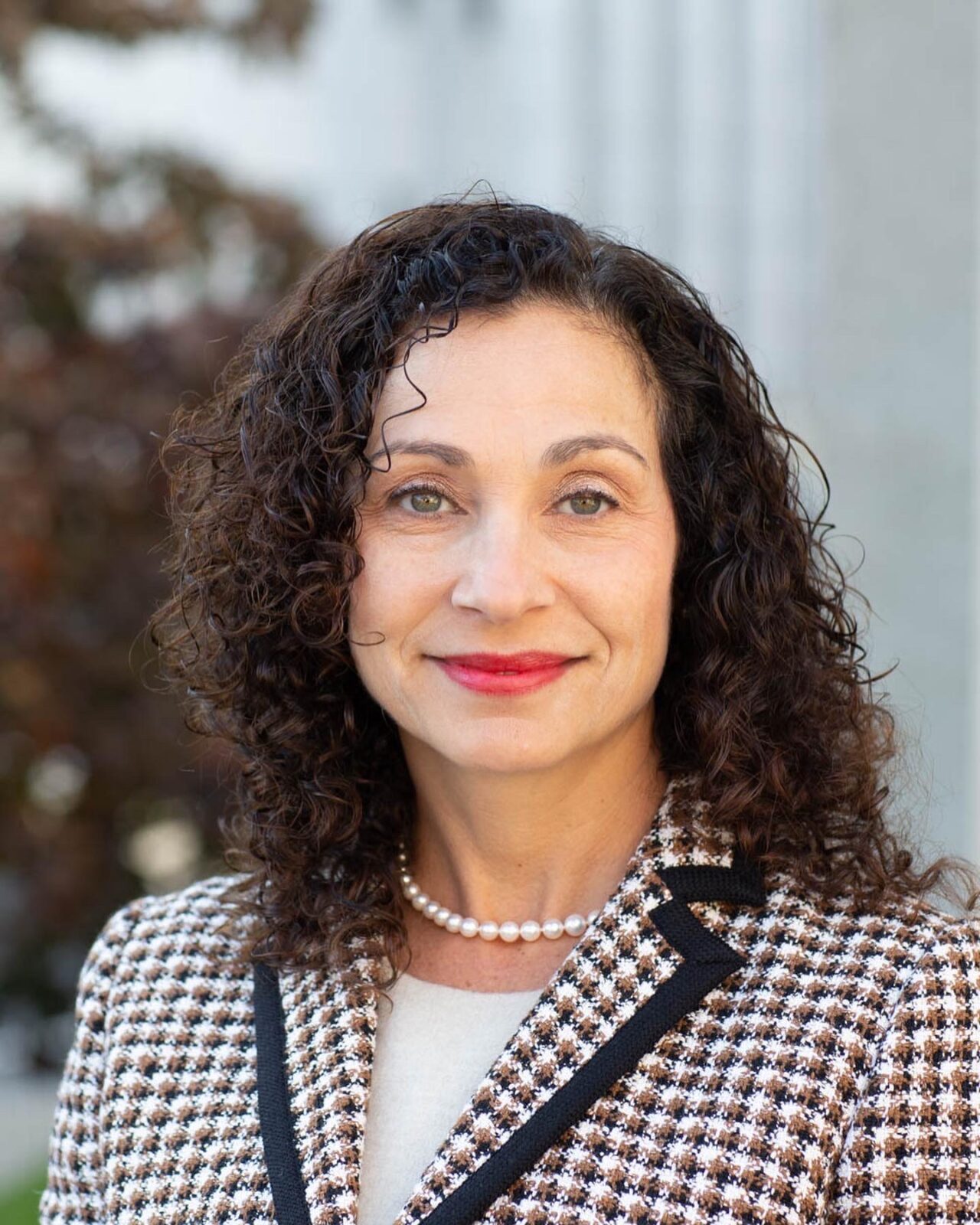NYSBA’s Noblest Act: Preventing War and Establishing a World Court
3.6.2023
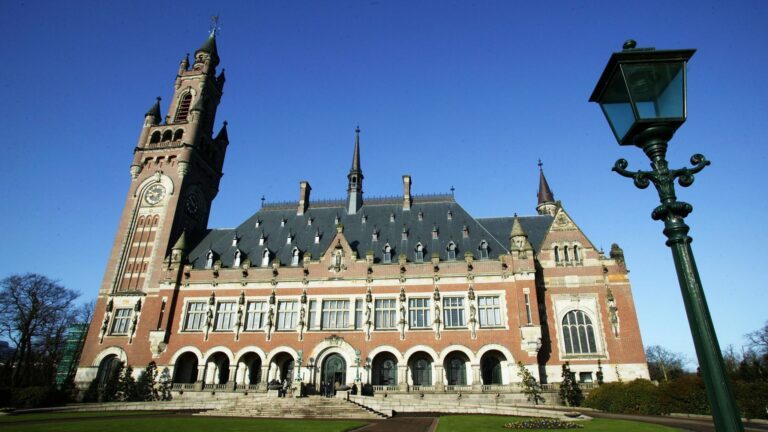
From its formative years, the New York State Bar Association has had an abiding interest in the world beyond the Empire State. Beginning in the 1880s, the Association’s annual meetings often included addresses on international law,(1) given by luminaries such as U.S. secretaries of state(2) and foreign dignitaries.(3) These presentations were arranged not merely to satisfy members’ curiosity but to project the organized bar’s influence across the globe. In fact, in 1896 and 1899, the Association worked with two U.S. presidents to prevent a war and create the first world court. This breathtaking accomplishment was called at the time “the noblest act that ever honored the name of [the] Association.”(4) It remains so today.
Of course, the world we now live in bears little resemblance to the 1890s fin de siècle. Our world is vastly more complex and dangerous. Terrorism is an ever-present danger, and nuclear-armed countries threaten each other and this nation. So, the ideas the Association long ago gifted statesmen to maintain peace among nations are inadequate to meet the challenges of the current geopolitical environment. But the story about that gift is well worth telling simply for what it says about the capacity of the organized bar to do the public good.
The Venezuelan Crisis of 1895
The Association’s glorious heritage in world affairs arose from the Venezuelan crisis of 1895, which brought the U.S. and Great Britain to the brink of war. A long-simmering boundary dispute between Venezuela and the contiguous British colony of British Guiana (today Guyana) was the potential casus belli. The British wanted to acquire area on the Orinoco River to control a vast region on the shoulder of the southern continent. But U.S. President Grover Cleveland believed that that would violate the Monroe Doctrine – the principle that the Western Hemisphere was closed to colonizing by European powers.(5)
In July 1895, the Cleveland Administration warned Great Britain that it would intervene in the border dispute if the contested territory was forcibly seized. Great Britain did not budge, prompting Cleveland to send Congress a special message declaring that the U.S. would use “every means in its power to protect Venezuelan territory.”(6)
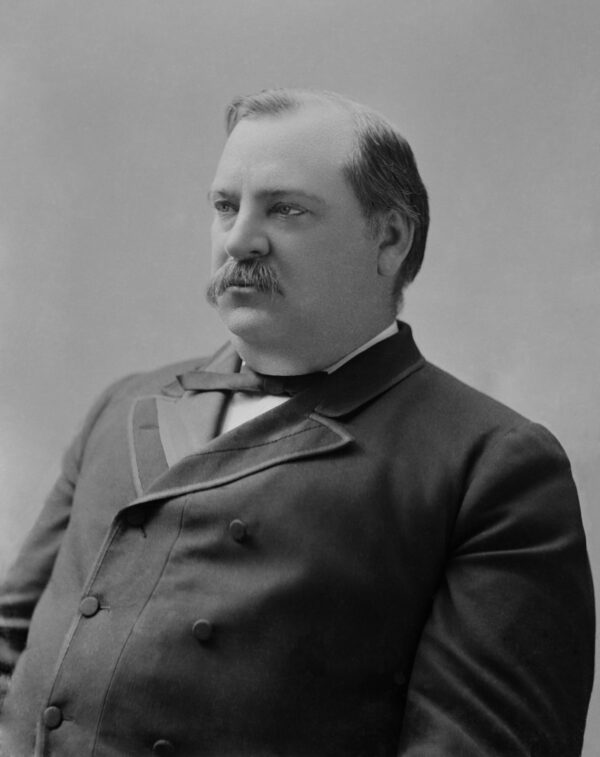
(Left: President Grover Cleveland)
Cleveland’s threat ignited a “blaze” that swept the nation.(7) Leading statesmen and the press called for war.(8) But such sentiments were not universal. A near panic descended on Wall Street. Corporate lawyers believed their clients were better served by peace than war. Experts on international law challenged Cleveland’s interpretation of the Monroe Doctrine. Plus, the U.S. was in no position to combat Britain’s superior naval power.(9)
The Association Proposes an International Court of Arbitration
With war drums loudly beating, on the evening of Jan. 21, 1896, the Association convened for its 19th Annual Meeting at Odd Fellows’ Hall in Albany.(10) The leadership believed the Association had a duty to shape public opinion on how to peacefully resolve not only the Venezuelan border dispute but also “all international controversies that appear to be beyond adjustment by ordinary diplomatic agencies.”(11) To that end, Chauncey M. Depew, “America’s prince of orators,”(12) delivered the opening address entitled, “Patriotism and Jingoism: The Lawyer’s Duty.”(13)
Depew, a lawyer, was president of the New York Central Railroad and a prominent figure in Republican politics, cutting his oratorical teeth campaigning for Abraham Lincoln in the 1860 presidential election. He devoted his career to railroad law with stints in elected office. From 1899 through 1910 he served as a U.S. Senator from New York.(14)
Following an introduction by the Association’s president in which he was likened to Moses,(15) Depew stood before a “large and cultured” audience that included prominent lawyers from across the state, the judges of the Court of Appeals, the Lieutenant Governor, many state Supreme Court Justices, and a large number of legislators.(16) Warming to his subject, Depew observed that the Association had never assembled “at a period so interesting and at the same time so fraught with dangers.” He implored the Association to offer the nation a means of preventing war, because “[t]he larger the question and the greater perils involved in its decision, the more clear is the mission of the Bar Association to give the subject its attention and to the country the results of its calm deliberation.”(17)
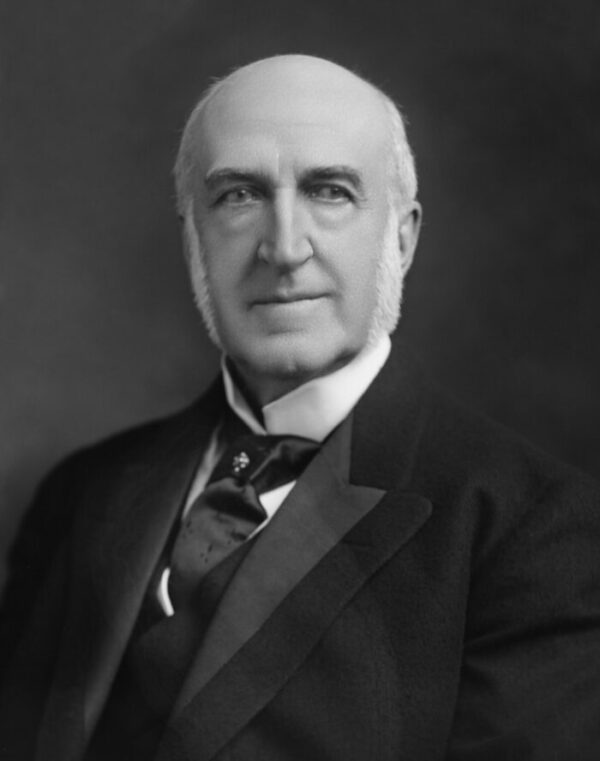
Depew condemned war and politicians who would exploit it for political purposes. He cited the examples of Attila the Hun, Julius Caesar, Hannibal, Genghis Kahn and Napoleon, observing that war-mongering dictators replace the Rule of Law with the “Law of the Sword.”(18) He quoted Cicero’s maxim silent leges inter arma (“in times of war, the law falls silent”) and described the horror and cost of modern-day warfare.(19)
(Right: Chauncey M. Depew)
Depew expressed shock at the “unanimity and hot haste” with which Congress responded to Cleveland’s Venezuelan message, “record[ing] their approval of what they believed at the time to be a declaration of war.”20 “The lesson seems to be enforced,” Depew said, “that a hasty or passionate president could plunge the nation into war, and the reason and justification for its sacrifices of blood and treasure and industrial interests would be left for academic discussion after the strife was over.”(21)
Depew offered a novel cure to prevent war between nations: an international court of arbitration.(22) Replacing war with legal process, he argued, would preserve peace, the only route to “the preservation and perpetuity of civilization and liberty.”(23) To “honor and safely move upon the pathway of peace,”(24) Depew urged lawyers in the U.S. and Great Britain to “agitate and educate for the creation of this great court.”(25)
Depew’s clarion call to replace war with judicial processes for the peaceful settlement of disputes struck a chord with lawyers.(26) It appealed to their conviction that controversies may be settled by conciliation, arbitration and courts of justice – that the “methods of the lawyer lead in the end to more permanent results than the methods of the warrior and that human relations must be based upon reason rather than upon force.”(27)
After Depew’s speech, Governor Levi P. Morton hosted a lavish reception at the Executive Mansion for the Association and legislators. According to the New York Times, it was the “most brilliant affair of its kind ever held in the mansion.” A large orchestra played, fresh cut flowers were on display and guests met the governor and his wife on a receiving line.(28)
The next day, the Association assembled and acted on Depew’s recommendation. “[I]mpelled by a sense of duty to the state and nation and a purpose to serve the cause of humanity everywhere,”(29) a motion was made and carried creating a Committee on Arbitration to consider the subject of international arbitration and devise a plan to create a permanent court to resolve disputes between Great Britain and the U.S.(30) The committee’s members included present (William H. Robertson31), past (Sherman S. Rogers32) and future (Edward G. Whitaker33 and Walter S. Logan34) Association presidents. Like most leading members of the bar in that era, they were statesmen with practical experience in government and public policy. Likewise, the committee’s chair, William D. Veeder, was a former U.S. Congressman, state legislator and jurist.(35) The other members – Charles M. Davison (the committee’s secretary(36), Charles A. Deshon,(37 John Ingersoll Gilbert(38) and W. Martin Jones(39) – also distinguished themselves in public service. Depew served as an advisory member to the committee, as did Professor John B. Moore of Columbia University, a former assistant secretary of state and leading authority on international arbitration.(40)
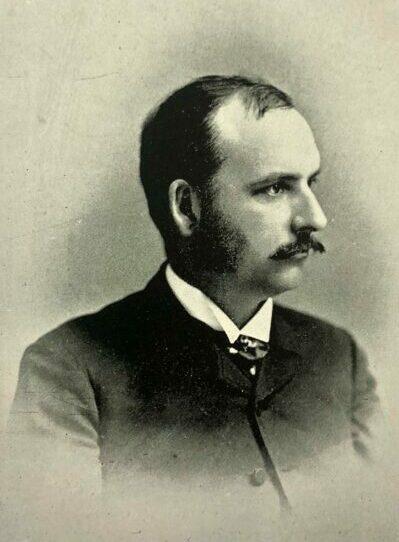
On Feb. 12, 1896, the committee held its first meeting in Manhattan.(41) The committee’s charge specified consideration of a court limited to members from the U.S. and Great Britain.
(Left: Edward G. Whitaker)
However, W. Martin Jones, a foreign policy expert with prior service in the U.S. State Department,(42) advocated establishing a “permanent international court of arbitration” composed of representatives from several nations.(43) The committee agreed, concluding that to establish a court for only two nations would be impractical if not impossible and decided to plan a tribunal open to all nations.(44) A subcommittee, on which Jones and Logan served, was tasked with crafting a plan for such a court.(45)
Jones drafted a report which argued that an Anglo- American tribunal would be impractical, as a court made of an equal number of judges from each nation would be forever paralyzed.(46) Jones proposed instead a permanent tribunal composed of judges nominated by the highest court of nine nations (Argentina, Brazil, France, Germany, Great Britain, Mexico, the Netherlands, Russia and the U.S.) to which would be submitted international disputes that threaten global peace and prosperity. Jurisdiction would be conferred by treaties requiring the parties to submit disputes to the court and binding them to abide by its decision. The court would be open, under certain conditions, to all nations, including those represented on the court.(47)
Also, the subcommittee prepared an eloquent “memorial” to President Cleveland,(48) urging him to implement the Association’s plan.(49) To assist in its lobbying efforts, the Association enlisted the support of the organized bar across the country. On March 18, a circular letter was sent to the officers of every state bar association “to unite the sentiment and judgment of the bar of the entire country.”(50) The response from several state bars was encouraging: some formed like committees, while others promised to take such action at their coming annual meetings.(51) In an admiring editorial The American Lawyer, a monthly journal, wrote:
It is seldom that a proposition involving so much departure from established and ancient methods, which in itself is so radical an innovation that it is denounced as Utopian by high authority, merits with so cordial and undoubted an acceptance as has the proposition definitely inaugurated by the New York State Bar Association for the creation of the mightiest Court the world has ever known. The fact of such unanimous sanction from trained legal minds, and from men who rightly stand as the official representatives of the American bar, gives strong prophecy of the due consummation of the hope of all men who believe in the supremacy of reason and conscience over brute force and conscienceless argument of arms.”(52)
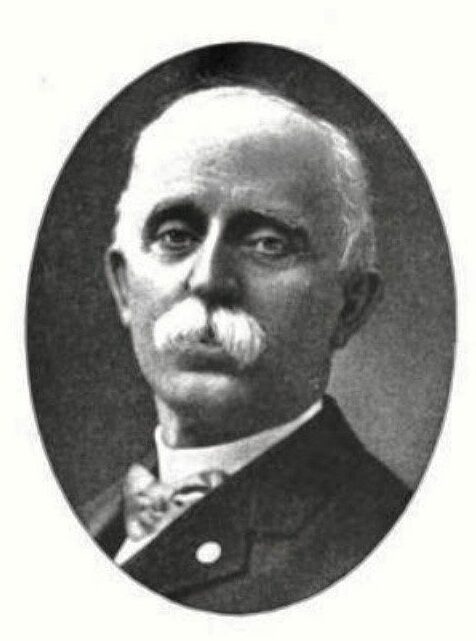
(Left: W. Martin Jones)
On March 26, 1896, the Committee on Arbitration held its final meeting at which it adopted the subcommittee report.(53) Because the committee exceeded its charge – by proposing a world court rather than a mere Anglo-American body – the Association needed to consider the matter. That occurred on April 16, when the first special meeting in Association history was held at the State Capitol in Albany. It took an hour for a small but determined group to listen to a reading of the report and adopt a slightly amended version.(54) A three-person delegation was appointed to personally present to Cleveland the plan and memorial: Whitaker, the Association’s president; Veeder, the Committee on Arbitration’s chairman; and Jones, the author of its report.(55)
Thus, in less than three months, the Association devised an “unpardonably audacious” plan that contemplated “a transformation of governments and an obliteration of traditions of people” with respect to the resolution of international conflict.(56) The plan was thought by some to be the first step any influential body had ever taken to establish a permanent international court of arbitration.(57)
President Cleveland Meets Association Leaders at the White House
It took only five days to secure a face-to-face meeting with the nation’s Commander in Chief, who happened to be a New York lawyer and former Association vice president.(58)
On April 21, the Association’s representatives met for nearly an hour with Cleveland at the White House in Washington, D.C.(59) After a cordial greeting by Cleveland, all took their seats, and Whitaker explained the purpose of the visit and presented the Association’s memorial and plan, handsomely printed in book form bound in an illuminated cover with the words of Ulysses Grant, “Let Us Have Peace,” printed in red letters at the top.(60)
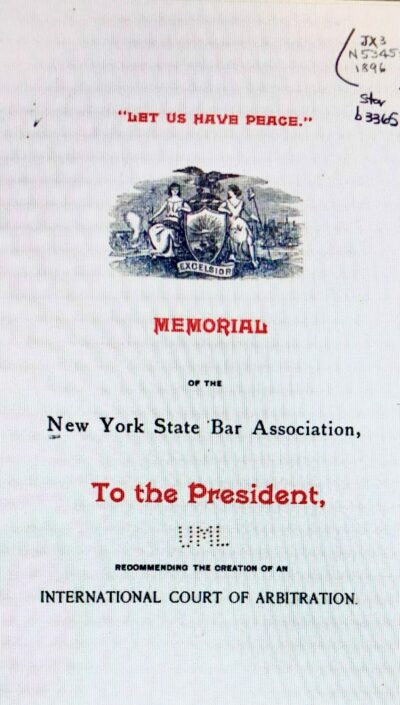
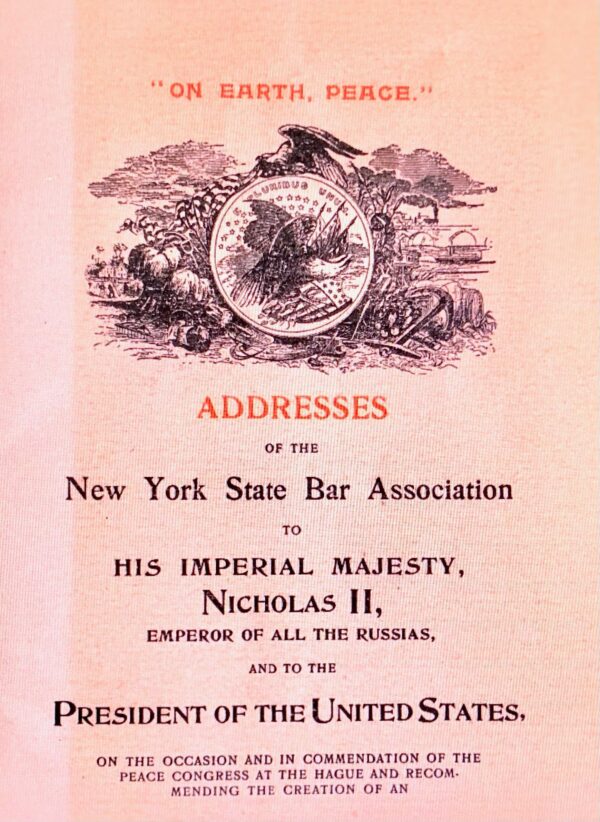
(Near Right: 1899 NYSBA Address to Czar Nicholas II and President William McKinley / Far Right: 1896 NYSBA Memorial to President Grover Cleveland)
Cleveland told the delegation he was “deeply impressed with the unselfish efforts of the Association” and pledged to carefully study its suggestions, intimating that they “would be of great practical interest to the Government.”(61) Indeed, the Association gave Cleveland precisely what he and his Secretary of State, Richard Olney, needed at precisely the right time. The furor over the Venezuelan message opened their minds to alternatives to war.(62) Cleveland said as much, telling his callers: “[T[here is one fact about the matter: you have a plan; nobody else has given us a plan.”(63)
After a lengthy discussion, the Association representatives rose to leave, but Cleveland asked them to be seated again and the discussion continued. Upon concluding the meeting, Cleveland cordially shook hands and thanked them, revealing his pleasure that the constructive ideas they shared came from fellow members of the New York bar.(64)
The Border Crisis Is Resolved Through Arbitration
Jones, Veeder and Whitaker left the White House believing that Cleveland agreed with the Association’s plan and that he would do his best to bring about what it “sought to secure, the inauguration of a movement by which differences may be settled without resort to arms.”(65) This assessment was soon confirmed, as Cleveland became an exponent of arbitration.(66)
In November 1896, less than a year after the White House meeting, an elated Cleveland announced the completion of negotiations with Great Britain to enter into a convention for arbitration.(67) In February 1897, a month before Cleveland left office, a treaty was inked in Washington, D.C. between Great Britain and Venezuela that submitted their border dispute to arbitration. As the Association recommended, the treaty called for a judicial mechanism to resolve the dispute; specifically, an arbitration tribunal to “determine the boundary line between the Colony of British Guiana and Republic of Venezuela,” composed of five members: two named by Great Britain, two by the United States, and a fifth by common consent or, if they proved unable to agree, by the king of Sweden and Norway.(68) Two years later, on Oct. 3, 1899, the border dispute ended when the arbitration tribunal substantially upheld Great Britain’s claim, with a few of Venezuela’s arguments resolved in its favor.(69)
The Hague Peace Conference of 1899
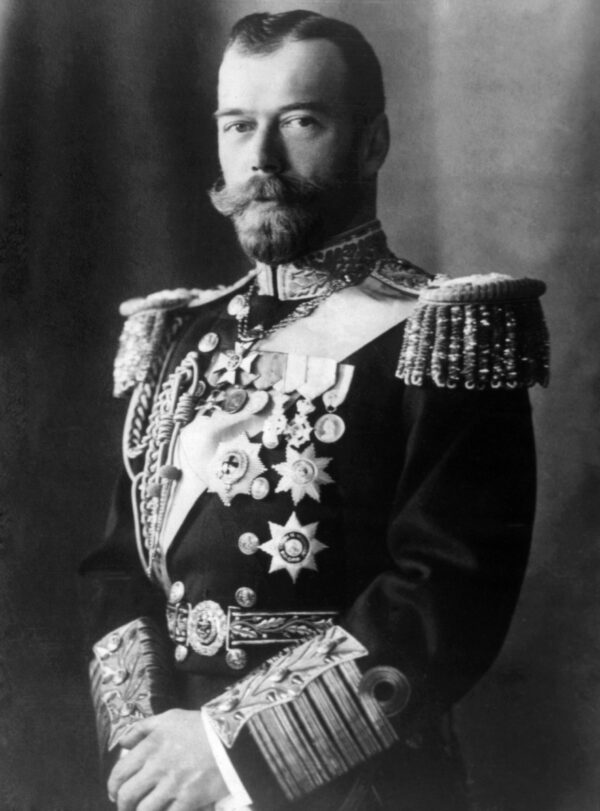
On Jan. 18, 1899, the Association formed a special committee to draft an address each to U.S. President William McKinley and the czar commending the Peace Conference and recommending international arbitration, “such address to be accompanied by a record of the previous action of the Association on this subject, and of its plan of a Court of Arbitration for the settlement of international controversies that may not be adjusted by diplomatic negotiations.”(72) The committee, in turn, prepared “very carefully and artistically” printed addresses.(73) On April 24, the Association delivered McKinley’s address to the White House and submitted the czar’s address through the U.S. Secretary of State to the Russian ambassador.(74) Copies of the Association’s plan were also transmitted through the State Department to the various delegations at the Peace Conference.(75)
(Above: Czar Nicholas II)
The Association’s Vision for a World Court Is Realized
On May 18, 1899, representatives from 26 countries gathered in The Hague for the Peace Conference.(76) President McKinley sent a distinguished Commission with instructions to establish a permanent international court of arbitration along the lines proposed by the Association.(77) Newspapers across the nation praised the Association for devising the “American Plan”(78) – as did conference participants and noted commentators.(79)
During the Peace Conference, the “great question” was whether the commissioners could bring into existence a permanent international court.(80) The American Plan faced significant obstacles. In particular, the German Commissioners opposed the idea of obligatory arbitration.(81) The chair of the American Commission, Andrew D. White, was an experienced diplomat who previously served as U.S. Ambassador to Germany. He dispatched the delegation’s secretary, Frederick W. Holls (a New York lawyer) to Berlin to communicate the strength of feeling in America, especially among persons of faith, in favor of peacefully resolving international disputes.(82) Ultimately, German opposition was withdrawn when a purely voluntary arbitration scheme was put on the table.(83) That cleared the way for the Peace Conference to adopt the Convention for the Pacific Settlement of International Disputes. It provided for a Permanent Court of Arbitration (PCA) in The Hague, always open, with power to hear and decide disputes between nations, in accordance with specified rules of procedure.(84)
Ringing paeans of praise came the Association’s way for its role in the establishment of the first global mechanism for the settlement of disputes between nations. PCA – which remains in existence – marked a new era in international law and justice.85 As a former Secretary of State observed at the Association’s annual meeting:
This Association has worthily earned the commendations of the world for its influential part in the creation of The Hague Permanent Court of Arbitration, and every lawyer in the other States of the Union honors his professional brethren of the empire State for this conspicuous service to the cause of justice and peace. . . . It is especially to the credit of the profession in this State that it has made its Association such an efficient instrument in promoting the establishment of the International Tribunal at The Hague.(86)
Through the years the Association remained a champion of international courts and international arbitration.87 It never hesitated to throw the “weight of its great moral influence” toward sustaining institutions for promoting international peace, such as the Permanent Court of International Justice, the forerunner of the International Court of Justice, which today is a main organ of the United Nations.(88)
(Below: The Hague Peace Conference)
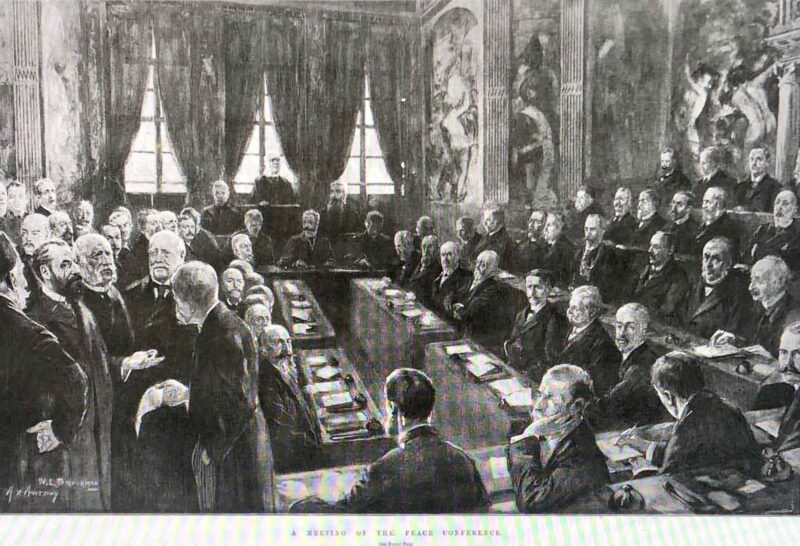
Despite the Association’s continuing commitment to ending war by peaceful means, the remedies it offered in the horse-and-buggy era seem impractical, if not utopian, today. The 20th century’s two World Wars – and countless smaller ones – shattered the illusions of the Hague Peace Conference. So, too, the crimes against humanity Russia now perpetrates against the Ukrainian people. Clausewitz’s famous dictum that “war is a continuation of policy with other means” is a superior guide to the current nature of war than the legal theories of the 1890s.
Still, the Association’s heritage to secure peace through law is an imperishable gift. What is deathless about the work done in 1896 and 1899 is the altruism and high-minded purpose that inspired it. The Association’s service to the cause of justice and peace is a blessing that descends upon present and future bar leaders. To be worthy of this inheritance, leaders must be no less idealistic, no less audacious, no less singular, than their predecessors. May they be so.
Please watch a special edition of “Miranda Warnings: the History of NYSBA” conversation with Hank Greenberg on this topic here.
NYSBA Letter from 1896 Inviting Members to Attend Annual Meeting at Which Chauncey DePew Delivered Opening Address
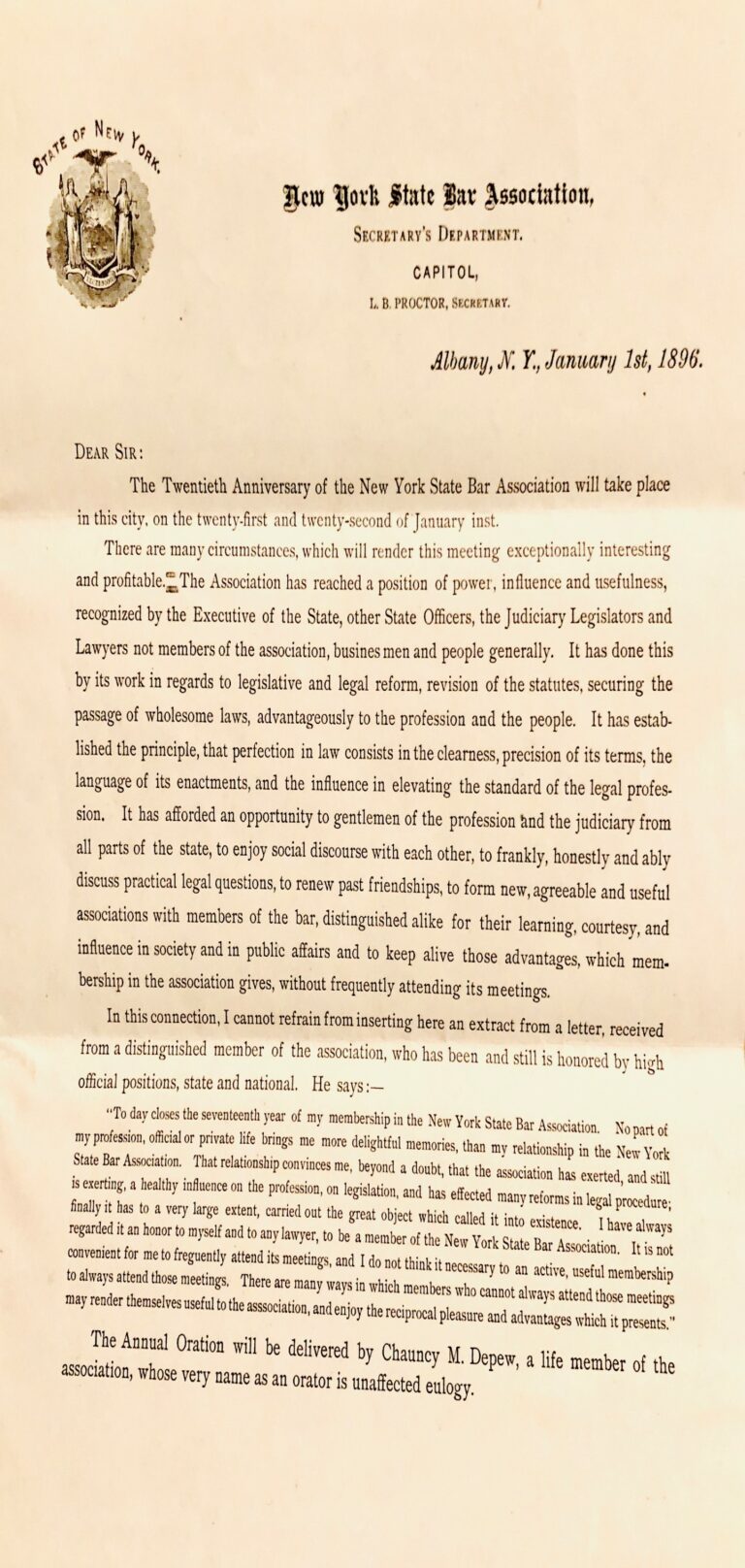
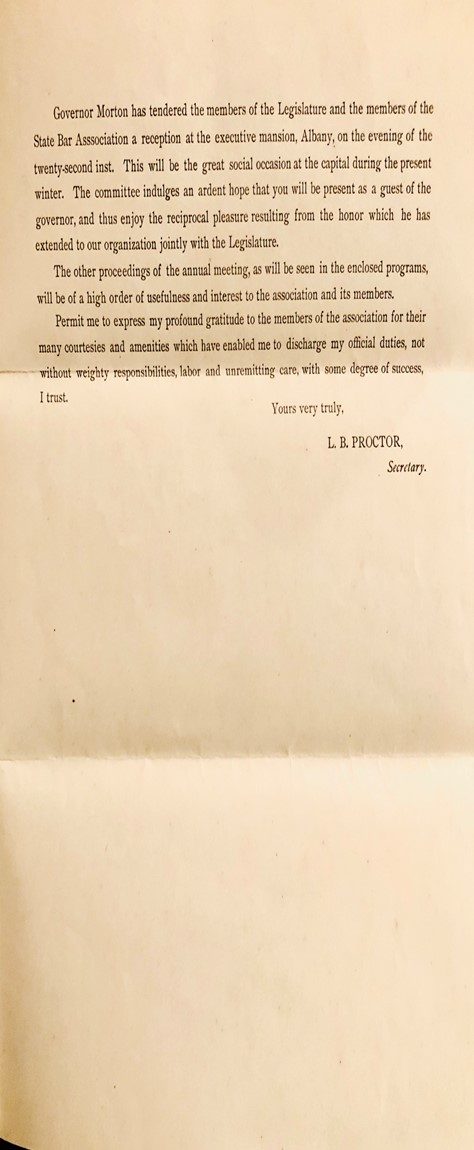
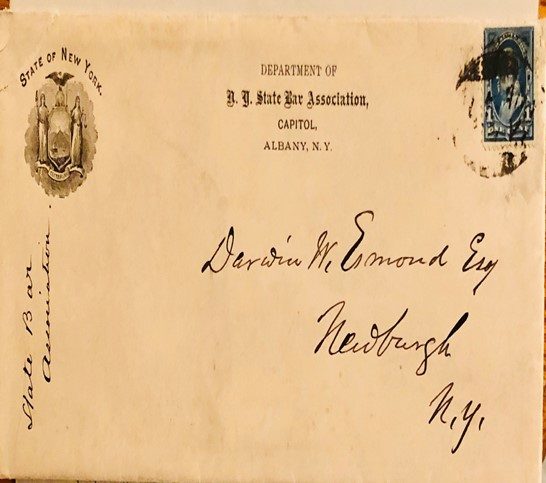
Endnotes
[1.] See, e.g., Deborah S. Gardner & Christine G. McKay, Of Practical Benefit: New York State Bar Association, 1876-2001 19 (2003) (noting that, at the 1882 annual meeting, Hon. George S. Batchellar, a judge of the International Tribunal in Egypt, delivered an address on “Principles of Extra-Territoriality in the Ottoman Empire and Mixed Courts of Egypt”) [hereinafter Of Practical Benefit].
[2.] Former U.S. Secretaries of State that delivered addresses at annual meetings include John W. Foster in 1904; Elihu Root in 1910; and Charles Evans Hughes in 1926. At the 1959 Annual Meeting, Secretary of State John Foster Dulles delivered his last public speech, before he died, on The Role of Law in Peace. John Foster Dulles, The Role of Law in Peace, Address before the New York State Bar Association, Jan. 31, 1959, Department of State, Series 8 – No. 79 (U.S. GPO 1959).
[3.] At the 1902 Annual Meeting, for example, the French Ambassador, Jules Cambon, delivered an address on “the Relation of Diplomacy to the Development of International Law, Public and Private.” See Address by His Excellency Jules Cambon, Proceedings of the New York State Bar Association, Twenty-Fifth Annual Meeting 336, 126-42 (1902). In a similar vein, at the 1918 annual meeting, during WWI, the Attorney General of Great Britain, Sir. Frederick Edwin Smith, delivered the annual address on “Law, War, and the Future.” Annual Address by the Attorney General of Great Britain, Proceedings of the New York State Bar Association, Forty-First Annual Meeting 258–81 (1918).
[4.] In 1901, Hon. John H. Stiness, the Chief Justice of the Rhode Island Supreme Court, praised the Association’s efforts to establish a permanent court of international arbitration as “the noblest act that ever honored the name of that Association.” Report of the Committee on International Arbitration, Proceedings of the New York State Bar Association, Thirty-Fourth Annual Meeting 261, 263 (1911) (quoting Chief Justice on H. Stiness). See also Charles Evans Hughes, The Permanent Court of International Justice, Proceedings of the New York State Bar Association, Forty-Ninth Annual Meeting 333, 336 (1926) (“I don’t know if you are fully aware how glorious your tradition is.”); Charles Evans Hughes, Speech at the National Arbitration and Peace Congress, New York City, April 15, 1907, reprinted in Addresses of Charles Evans Hughes 1906–1916, 209, 211 (2d ed. 2016) (“New York . . . should take special pride in the intelligent service in the cause of international arbitration which was rendered by the lawyers of this state.”).
[5.] Alyn Brodsky, Grover Cleveland, A Study in Character 366–70 (2000) [hereinafter Cleveland]; Henry F. Graff, Grover Cleveland 123–24 (2002) [hereinafter Grover Cleveland].
[6.] Brodsky, Cleveland, supra note 5, at 371–72; Graff, Grover Cleveland, supra note 5, at 124–25.
[7.] George C. Herring, From Colony to Superpower: U.S. Foreign Relations Since 1876, 307 (2002) (quoting the New York World) [hereinafter From Colony to Superpower].
[8.] See, e.g., Brodsky, Cleveland, A Study in Character, supra note 5, at 373 (quoting U.S. Senator Henry Cabot Lodge and newspapers such as the Sun, Courier-Journal and Washington Post).
[9.] Calvin DeArmond Davis, The United States and the First Hague Peace Conference 27 (1962) [hereinafter First Hague Peace Conference]; Brodsky, Cleveland, supra note 5, at 366–67; Graff, Grover Cleveland, supra note 5, at 125; Robert Kagan, The Ghost at The Feast: America and the Collapse of World Order, 1900–1941, 23 (2003)
[10.] Odd Fellows’ Hall (which no longer exists) was located on the corner of Howard and Lodge Street.
[11.] Addresses of the New York State Bar Association to His Imperial Majesty, Nicholas II, Emperor of All the Russias, and to the President of the United States, on the Occasion and in commendation of the Peace Congress at the Hague and Recommending the Creation of an International Court 6–7 (Apr. 24, 1899), available at https://www.loc.gov/resource/gdcmassbookdig.addressesofnewyo00unse [hereinafter Addresses to Nicholas II and President]. The text of the addresses was reprinted in Proceedings of the New York State Bar Association, Twenty-Second Annual Meeting 500 (1899).
[12.] Walter S. Logan, A Few Suggestions on Lord Chief Justice Russell’s Address at Saratoga, Proceedings of the New York State Bar Association, Twentieth Annual Meeting 41 (1897) [hereinafter Logan, Twentieth Annual Meeting].
[13.] Address of Hon. Chauncey M. Depew, Proceedings of the New York State Bar Association, Nineteenth Annual Meeting 21–40 (1896) [hereinafter Address of Hon. Chauncey M. Depew].
[14.] Gardner & McKay, Of Practical Benefit, supra note 1, at 19; Chauncey M. Depew Dies of Pneumonia in his 94th Year, N.Y. Times, April 5, 1928, at p. 1, col. 7.
[15.] The custom at annual meetings was for the Association’s president to deliver the opening address. But the president, William H. Robertson, chose not to do so, explaining to the audience: “The greatest mistake that Pharaoh made in all his life, was in attempting to following Moses through the Red Sea. If your president had attempted to follow Dr. Depew in his eloquent address, he would have committed a greater blunder than Pharaoh.” Address of Hon. Chauncey M. Depew, supra note 13, at 21.
[16.] MR. DEPEW ON “JINGOISM” – HE DISCUSES WAR BEFORE THE STATE BAR ASSOCIATION – LAWYERS SHOULD USE THEIR INFLUENCE FOR PEACEFUL SETTLEMENTS OF INTERNATIONAL DISPUTES –THE PRESIDENT’S VERSION OF THE MONROE DOCTRINE A NOVEL AND DANGEROUS ONE, N.Y. DAILY TRIBUNE, d Jan. 22, 1896, p. 10, col. 5; MR. DEPEW IS FOR PEACE – Tells New-York Lawyers They Should Work for Arbitration. – ADDRESS TO THE BAR ASSOCIATION – The United States and England Ought to Have a Board to Which All Their Disputes May Be Referred., N.Y. Times, Jan. 22, 1896, p. 16, col. 1; ANNUAL MEETING OF THE STATE BAR ASSOCIATION. – ADDRESS BY MR. DEPEW, Buffalo Courier, Jan. 22, 1896, p. 1, col. 1; EXALTED BY DEPEW – THE RESOURCES AND GREATNESS OF AMERICA DEPICTED ELOQUENTLY – IN AN ADDRESS TO LAWYERS – LAW OF ARBITRATION SHOULD SETTLE ALL INTERNATIONAL DISPUTES – BUT IF A WAR IS NECESSARY – There Should Be No Occasion for Uneasiness Among Our People., St. Paul Minnesota Daily Globe, Jan. 22, 1896, p. 4, col. 4.
[17.] Address of Hon. Chauncey M. Depew, supra note 13, at 22.
[18.] Id. at 24, 28.
[19.] Id. at 23, 26–27, 29.
[20.] Id. at 28.
[21.] Id. at 29; see also id. at 26 (“The alarms of war agitate a world. The columns of our daily papers are filled with cables and telegrams announcing the rage of nations and the immanence of their flying at each other’s throats. The battle blood which is the inheritance of the ages is aflame for fight.”).
[22.] Id. at 32, 35, 38–39.
[23.] Id. at 40; see also id. at 32 (urging lawyers “to perform a great work upon the lines of lawyers of the centuries in promoting arbitration”).
[24.] Id. at 35.
[25.] Id. at 40.
[26.] See, e.g., 53 Alb. L.J. 49, 50–51 (Jan. 25, 1896) (“If the recent meeting of the Bar Association had accomplished nothing else, it did allow a broad-minded man to forcibly, intellectually and brilliantly advocate the use of a modern and civilized means of settling dissensions and discord.”); Annual Address of Edward G. Whitaker, President of the New York State Bar Association, Delivered at Its Annual Meeting at Albany on January 20, 1897, Proceedings of the New York State Bar Association, Twentieth Annual Meeting 53, 58 (1897) (“The moving cause was a sudden and unexpected possibility of war between the United States and Great Britain. It brought the question of war or peace sharply before the people. And the lawyers, true to their peaceful instincts and sense of justice and humanity, were the first to realize that a war between the two great Anglo-Saxon races, the two great civilizing forces of the world, would be a calamity.”) [hereinafter Whitaker, Twentieth Annual Meeting].
[27.] Frederic R. Coudert, International Law Supreme, 15 N.Y. St. Bull. 25, 29 (1943); see also C. Roland Marchand, The American Peace Movement and Social Reform 1898–1918, 57 (1972) (“Ingrained habits of thought tended to lead the lawyers to envision all international problems as specific, definable legal disputes, amenable to judicial determination. . . . In other words, grave international problems could and should be reduced to a series of ‘justiciable disputes.’”).
[28.] GOV. MORTON’S GREAT RECEPTION The Most Brilliant Event that Has Ever Occurred Within the Walls of the Executive Mansion., N.Y. Times, Jan. 23, 1896, p. 4, col. 7.
[29.] Memorial of the New York State Bar Association to the President Recommending the Creation of an International Court of Arbitration 1 (Apr. 16, 1896), available at https://babel.hathitrust.org/cgi/pt?id=mdp.35112102630342&view=1up&seq=3 [NYSBA Memorial]. The text of the memorial was reprinted in Proceedings of the New York State Bar Association, Nineteenth Annual Meeting 290–95 (1896).
[30.] See Proceedings of the New York State Bar Association, Nineteenth Annual Meeting 60–61 (1896) (motion made and carried to establish a committee whose members would be appointed by the Association president “to consider and report upon the question of arbitration of differences between this country and England which has been so ably presented and urged by our distinguished citizen, Hon. Chauncey M. Depew.”), 138 (president announced five initial appointees), 218 (listing 11-members of the Committee).
[31.] Robertson was Association president in 1895. He was a prominent lawyer and politician who previously served as a State Assemblymen (1849–50) and State Senator (1854–1855 and 1872–1881), Judge of the Westchester County Court (1856–1866), and U.S. Congressman (1867-1879). See HON. WILLIAM H. ROBERTSON DEAD – DIED AT HIS HOME IN KETONAH – Senator, Congressman, Judge, Presidential Elector, Collector, Mt. Vernon Daily Argus, Dec. 6, 1898, pg. 1, col. 3.
[32.] Rogers was Association president from 1881 to 1882. He was a prominent lawyer and previously served as a state senator in 1876. Sherman S. Rogers, N.Y. Times, March 24, 1900; 61 Albany L.J. 193 (March 31, 1900).
[33.] Whitaker was Association president from 1896 to 1897. He previously served as a Deputy Attorney General and Supreme Court Justice. EDWARD G. WHITAKER, EX-JUSTICE, IS DEAD; Retired Jurist of Supreme Court Succumbs to Heart Disease in Southampton at 79., N.Y. Times, July 26, 1931, p. 4, col. 1.
[34.] Logan was Association president in 1899. He was a prominent lawyer and reformer, who devoted much time to public affairs. For example, in 1887 to 1889 he served as chairman of the Executive Committee of the Ballot Reform Association of New York State. See Biography of Walter Seth Logan, Proceedings of the New York State Bar Association, Thirtieth Annual Meeting 344–48 (1907); WALTER SETH LOGAN in 3 New York State’s Prominent and Progressive Men: An Encyclopedia of Contemporaneous Biography 187–89 (Mitchel C. Harrison, ed., 1902); W. S. LOGAN FALLS DEAD IN EQUITABLE BUILDING – The Lawyer Stricken Suddenly with Angina Pectoris – ASSOCIATE OF CHAS. O’CONNER – He Served Also As President of the State Bar Association-Club Man and Reformer, N.Y. Times, July 20, 1906, at p. 7, col. 5; W. S. LOGAN DROPS DEAD. – Lawyer Succumbs to Apoplexy, Brought on by the Heat, N.Y. Daily Tribune, July 20, 1906, at p. 7, col. 4.
[35.] Veeder was a former U.S. Congressman (1877–1879), state assemblyman (1885– 86), member of the State Constitutional Convention in 1867–68, and Surrogate of Kings County (1867–1877). William D. Veeder, Brooklyn Daily Eagle, Dec. 4, 1910, at p. 12, col. 6.
[36.] Davison was a prominent attorney and office holder from Saratoga Springs. He had been appointed by President Cleveland to be a delegate to the World’s Educational Convention and later served as a Commissioner of the Northern District of New York. CHAS. M. DAVISON, FORMER OFFICER HOLDER HERE, DEAD – Attorney Had Served as Supervisor and U.S. Commissioner, The Saratogian, April 9, 1932, p. 1, col. 2.
[37.] Deshon was a prominent lawyer, who organized and served as President of the New York Southern Society and Columbia Boat Club. CHARLES AUGUSTUS DESHON in Year Book New York Southern Society For the Year 1919–20, 70–74 (1919).
[38.] Gilbert was a former state assemblymen, state senator and Delegate to the State Constitutional Convention of 1894. John Ingersoll Gilbert., N.Y. Times, Dec. 20, 1904, p. 9, col. 6.
[39.] Jones was one of Rochester’s most distinguished lawyers. During the Lincoln administration, he served as the private secretary to Secretary of State William H. Seward. He was promoted to Chief Clerk of the Consular Bureau at the State Department. He then served as U.S. Counsel at Clifton Canada (1866–1871). He later ran unsuccessful campaigns for New York Attorney General (1885) and Governor (1888). See Biography of W. Martin Jones, Proceedings of the New York State Bar Association, Thirtieth Annual Meeting 338, 338–40 (1907) [hereinafter W. Martin Jones, Thirtieth Annual Meeting]; William Martin Jones in New York State Men: Biographic Studies and Character Portraits, 167 (Frederick S. Hill, ed., 1910) [hereinafter William Martin Jones, New York State Men]; Rochester and Monroe County New York: Pictorial and Biographical, 318–22 (1908) (detailed biography of Jones) [hereinafter Rochester and Monroe County].
[40.] See, e.g., Davis, First Hague Peace Conference, supra note 9, at 14 (“John Bassett Moore at Columbia became the country’s leading scholar in the field [of international arbitration].”); PLAN FOR PEACE: EXPERTS’ VIEWS. – President Angell of Michigan and Dr. Rogers of Northwestern Discuss It. – CREDIT TO NEW YORK BAR, Chicago Tribune, June 2, 1899, p. 1, col. 1–2 (noting that the Association’s Committee on International Arbitration was assisted by “Professor J. B. Moore of Columbia University, at one time the Assistant Secretary of State, and a leading authority upon the subject of international arbitration”) [hereinafter PLAN FOR PEACE].
[41.] W. Martin Jones, The Plan of the New York State Bar Association, Report of the Fifth Annual Meeting of the Lake Mohonk Conference on International Arbitration, 43 (1899) [hereinafter The Plan of the New York State Bar Association].
[42.] See supra note 39 and accompanying text.
[43.] Rochester and Monroe County, supra note 39, at 318 (“At the first meeting of the committee Mr. Jones set forth his views and pointed out the difficulties attending arbitration where the litigants only are arbiters, and strenuously advocated the establishment of a ‘permanent international court of arbitration composed’ of representatives of several nations.”).
[44.] Jones, The Plan of the New York State Bar Association, supra note 41, at 43 (“As lawyers, we saw that litigants cannot sit on juries to determine questions of facts, or even question of law, between themselves; that humanity has not yet reached that stage of development when men who are citizens and subjects of a litigant nation can enter into consideration of a disputed question and reach a conclusion unbiased by the circumstances by which they are surrounded.”).
[45.] Report of Sub-Committee on International Arbitration, Proceedings of the New York State Bar Association, Nineteenth Annual Meeting 276, 288 (1896) [hereinafter Report of Sub-Committee]; W. Martin Jones, Thirtieth Annual Meeting, supra note 39, at 340–41.
[46.] Report of Sub-Committee, supra note 45, at 276–80; William Matin Jones, New York State Men, supra note 39, at (“A prime mover in establishing a Permanent International Court of Arbitration, he drafted the plan of the New York State Bar Association and was member of the committee to present the memorial to the President, April 21, 1896.”); Rochester and Monroe County, supra note 39, at 319 (Jones “pre-pared a report which was successively approved, without alteration or amendment, by the sub-committee, the whole committee, and the Bar Association at a special meeting called to consider the matter.”).
[47.] Report of Sub-Committee, supra note 45, at 281–87; see also Walter S. Logan, Working Plan for a Permanent International Tribunal, Report of the Second Annual Meeting of the Lake Mohonk Conference on International Arbitration 59, 62-66 (1896) (describing the Association’s plan).
[48.] See NYSBA Memorial, supra note 29.
[49.] For example, the memorial closes with the following appeal to Cleveland: Believing that, in the fulfillment of its destiny among the civilized nations of the world, it has devolved upon the younger of the two Anglo-Saxon Powers, now happily in the enjoyment of nothing but future peaceful prospects, to take the first step looking to the permanency of peace among nations, your Petitioner, representing the Bar of the Empire State, earnestly appeals to you . . . to take such timely action as shall lead eventually to the organization of such a tribunal as has been outline in the foregoing recom-mendations. While ominous sounds of martial preparation are in the air, the shipbuilder’s hammer is industriously welding the bolt, and arsenals are testing armor plates, your Petitioner, apprehensive for the future, feels that delays are dangerous, and it urgently recommends that action be taken at once by you to compass the realization of the dream of good men in every period of the world’s history, when nations shall learn war no more and enlightened Reason shall fight the only battles fought among the children of men. NYSBA MEMORIAL, supra note 29, at 6–7.
[50.] FOR INTERNATIONAL ARBITRATION. New-York State Bar Association Ready to Begin the Work., N.Y. Times, March 26, 1896, p. 4, col. 5 [hereinafter FOR INTERNATIONAL ARBITRATION]; see also Report of Sub-Committee, supra note 45, at 282 (recommending that correspondence be opened immediately with other bar associations in the U.S. inviting them to join in the memorial to President Cleveland, “in order that action by the government of the United State be secured at as early a date as seems practicable and consonant with such an enterprise and the dignity of the undertaking”). The text of the circular letter read as follows: My Dear Sir – The New York State Bar Association, at its last annual meeting, appointed a Committee on International Arbitration, with power to devise and rec-ommend a plan for the organization of a permanent international tribunal, to which should be referred for peaceful settlement all controversies arising between English speaking people. This Committee is now organized and has inaugurated effort to various directions. It is desired to secure the co-operation of all like bodies, and we would ask whether your State Bar Association will not join us in this movement? It is hoped that a committee of your Association will be promptly appointed to act in concert with this committee, and we shall be glad to hear from you at your early convenience that this has been done. The plan of the work, generally, will be to agitate the question and create public and legal opinion in its favor, and, at the proper time, to initiate such practical methods, looking to the fulfillment of the purpose named as shall be deemed wisest in the judgment of those who combine in this effort. We send you by this mail, under separate cover, some printed mat-ter on this question, which may be of interest in connection with this communication. May we not hear from you favorably? Yours very truly, Frank C. Smith, Secretary Quoted in Proceedings of the Second Annual Meeting of the Iowa State Bar Association 30–31 (1896).
[51.] FOR INTERNATIONAL ARBITRATION, supra note 50 (“Correspondence has been opened with the officers of all the State Bar Associations, and in several instances, in response to the request of the committee, like committees for co-operative efforts have already been appointed. Others promise like action at their approaching annual meetings.).
[52.] INTERNATIONAL ARBITRATION – PLAN PROPOSED BY THE NEW YORK STATE BAR ASSOCIATION – OTHER STATE BAR ASSOCIATIONS COMING INTO LINE., The American Lawyer, 156, 156–58 (April 1896).
[53.] FOR INTERNATIONAL ARBITRATION, supra note 50.
[54.] Jones, The Plan of the New York State Bar Association, supra note 41, at 43-44; INTERNATIONAL ARBITRATION SCHEME. Report of the Committee to Consider One Submitted to the State Bar Association, N.Y. Herald, April 17, 1896, p. 4, col. 4 (took an hour to read report; adopted with some amendments); 53 Alb. L. J. 259–60 (April 25, 1896) (stating that special meeting was attended by a “small and determined” group that “accomplished what it meant to do,” although “nine-tenths” of the discussion “could have been dispensed with”).
[55.] W. Martin Jones, Thirtieth Annual Meeting, supra note 39, at 341.
[56.] Whitaker, Twentieth Annual Meeting, supra note 26, at 59.
[57.] See id. (“no definite and well considered plan for the peaceful settlement of international controversies had ever before been suggested even, and to the New York State Bar Association belongs the honor of having devised and formulated the first definite plan”); Report of Everett P. Wheeler on behalf of the Committee on International Arbitration, Proceedings of the New York State Bar Association, Thirty-Sixth Annual Meeting, 124–25 (1913) (the Association’s plan was “the first step that was taken by any organized body in this country, and I think in the world, in advocacy of an International Court of Arbitration, a permanent International Court, was taken by this Association”); Charles Evans Hughes, The Permanent Court of International Justice, Proceedings of the New York State Bar Association, Forty-Ninth Annual Meeting, 333, 335–36 (1926) (the Association “was the first influential [body] that sought to have established a Permanent Court of International Arbitration”).
[58.] In 1882, Cleveland, then the Association’s vice-president for the Eight Judicial District, was elected Governor of New York, on his way to becoming U.S. President a few years later. See New York State Bar Association, Reports, Vol. VII 100 (1884) (“At the last election, the people took up its [Association’s] President, the Hon. William C. Ruger, and made him the Chief Judge of the State; and they took up its Vice-President for the Eight Judicial District, the Hon. Grover Cleveland, and made him Governor of the State.”) (quoting Elliott F. Shepard).
[59.] Report of the Third Annual Meeting of the Lake Mohonk Conference on International Arbitration, 69 (1897) (remarks of W. Martin Jones, stating: “We had a conference which lasted nearly an hour, and went over this matter carefully and deliberately[.]”) [hereinafter Third Annual Meeting of Lake Mohonk Conference].
[60.] NYSBA Memorial, supra note 29. The “beautifully printed” memorial was also “distributed to the leaders of thought and leading statesmen and divines of the civilized world, and . . . received nothing but the most favorable comment.” Whitaker, Twentieth Annual Meeting, supra note 26, at 58.
[61.] Id.; A PLAN FOR ARBITRATION. Submitted to President Cleveland by the New- York Bar Association., N.Y. Times, April 22, 1896, p. 9, col. 6 (the Association’s representatives met for a half hour with Cleveland, who “promised to give careful consideration to the views presented”); see also PETITION FOR ARBITRATION – ACTION OF THE NEW YORK STATE BAR ASSOCIATION – IS AN ABLE DOCUMENT – RECOMMENDATIONS PRESENTED TO THE PRESIDENT – SCOPE OF THE TRIBUNAL – Abstract of the Report at the Committee of the Association- Suggestion as to the Settlement of Disputes Without Recourse to War., Rochester Democrat and Chronicle, April 22, 1986, p. 1, col. 7 [hereinafter PETITION FOR ARBITRATION]; WANT WARS STOPPED – New York Bar Association Asks the President to Favor a Court of Arbitration. – EARNEST PLEA FOR PEACE. – Outline in the Petition of the Proposed International Tribunal and Its Duties. – MR. CLEVELAND MUCH IMPRESSED. – He takes a Deep Interest in the Project and in the Conference To Be Held To-Day, N.Y. Herald, April 22, 1896, p. 7, col. 6.
[62.] Davis, First Hague Peace Conference, supra note 9, at 29 (“Secretary Olney had need for plans like that of the New York State Br Association, for he too had become a champion of arbitration.”); Jones, The Plan of the New York State Bar Association, supra note 41, at 44 (stating that Cleveland requested the delegation leave with him a copy of the report and memorial “for Mr. Onley, that he might make use of it”).
[63.] Third Annual Meeting of Lake Mohonk Conference, supra note 59, at 69 (W. Martin Jones quoting Cleveland) (emphasis in original).
[64.] PETITION FOR ARBITRATION, supra note 61.
[65.] Jones, The Plan of the New York State Bar Association, supra note 41, at 44.
[66.] Davis, First Hague Peace Conference, supra note 9, at 29.
[67.] SETTLEMENT OF VENEZUELAN MATTER A VICTORY. Many Congratulations Received – Venezuela Practically Ignored in the Final Negotiations – Further Delays Necessary, N.Y. Times, Nov. 12, 1876, p. 1.
[68.] Lars Schoultz, Beneath the United States: A History of U.S. Policy Toward Latin America 122 (1998); see also Herring, From Colony to Superpower, supra note 7, at 308 (“Britain agreed to arbitrate once the United States accepted its conditions for arbitration.”). At the Association’s 1897 Annual Meeting, Walter S. Logan, congratulated the membership for influencing the treaty between the U.S. and Great Britain providing for arbitration of the Venezuela dispute and the general treaty of arbitration entered into by the two powers shortly thereafter. Logan, Twentieth Annual Meeting, supra note 12, at 41, 42.
[69.] Brodsky, Cleveland, supra note 5, at 375.
[70.] Davis, First Hague Peace Conference, supra note 9, at 36–53; John Fabian Witt, Lincoln’s Code: The Laws of War in American History, 347–48 (2012) [hereinafter Lincoln’s Code].
[71.] Witt, Lincoln’s Code, supra note 70, at 348 (referring to peace movements in the world).
[72.] Proceedings of the New York State Bar Association, Twenty-Second Annual Meeting 357–58 (1899) (resolution to establish special committee made and adopted by the Association); see also id. at 125, 264 (earlier resolutions on the same subject). The members of this committee were W. Martin Jones, William D. Veeder and Edward G. Whitaker – the same three men who on behalf of the Association met with President Grover Cleveland on April 21, 1896. Addresses to Nicholas II and President, supra note 11, at 10.
[73.] Addresses to Nicholas II and President, supra note 11. Accompanying the addresses – which were “very carefully and artistically” printed – was the 1896 Memorial to Cleveland; the Association’s plan for an international court; and Chauncey Depew’s address to the Association at the 1896 Annual Meeting. Report of the Committee on Arbitration and motion relative thereto, Proceedings of the New York State Bar Association, Twenty-Third Annual Meeting, 249, 249–50 (1900) [hereinafter Report of the Committee on Arbitration].
[74.] Report of the Committee on Arbitration, supra note 73, at 249–50; see also Jones, The Plan of the New York State Bar Association, supra note 41, at 45 (“Before transmitting the Emperor’s address to the ambassador, to be forwarded to him, it was . . . submitted for inspection to the Secretary of State. He promptly replied that there was nothing in it that it would not be a pleasure to the Department at Washington to submit for transmission to the Czar by the hands of his ambassador.”).
[75.] Report of the Committee on Arbitration, supra note 73, at 250; W. Martin Jones, Thirtieth Annual Meeting, supra note 39, at 341–42.
[76.] Witt, Lincoln’s Code, supra note 70, at 348.
[77.] The members of the American Commission were Andrew D. White, Seth Low, Stanford Newel, Capt. Alfred T. Mahan of the United States Navy, Capt. William Crozier of the United States Army, and Frederick W. Holls, secretar. Davis, First Hague Peace Conference, supra note 9, at 64-80; see also Everett P. Wheeler, report of the Committee on International Arbitration, Proceedings of the New York State Bar Association, Thirty-Sixth Annual Meeting, 125–26 (1913) (“President McKinley received our second memorial and he instructed Andrew D. White and the other delegates to the conference at the Hague to advocate the establishment of an International Court of Arbitration and they did.”); Report of the Committee on Arbitration, supra note 73, at 250–51 (“It may be a matter of some gratification to the members of the a New York State bar association to know that it’s plan for a Court, to which, when appropriately organized, may be submitted controversies that baffle peaceful adjustment by diplomatic negotiation, was the plan, in substance, under the instruction of the President, that was advocated by representatives of this nation in conference at The Hague, and it may also be a matter of congratulation that portions of that plan were eventually adopted by the conference in its final action.”); Jones, The Plan of the New York State Bar Association, supra note 41, at 43 (stating that W. Martin Jones “had the pleasure of placing one of . . . [the Association’s] reports and the plan for a permanent court in the hands of President McKinley and of inviting his attention to it”).
[78.] See, e.g., PEACE CONFERENCE PLANS. – Views of President Angell and Henry Wade on the Arbitration Scheme – Bar Association Praised. N.Y. Evening Post, June 2, 1899, p. 7, col. 5 (“‘The New York bar has the honor of having practically worked out the plan which our representatives at The Hague have adopted as their own and which has been received with marked favor by the representatives from the countries participating in the congress of nations now in session.’”) (quoting Henry Wade Rogers, the President of Northwestern University and an international law expert); PLAN FOR PEACE, supra note 40 (“[The Association’s plan] . . . is practically the plan proposed by the New York State Bar Association in 1896. The plan was worked out carefully by a committee created for the purpose, and composed of some of the leading members of the bar of the state, assisted by Professor J. B. Moore of Columbia University, at one time the Assistant Secretary of State, and a leading authority upon the subject of international arbitration.”) (quoting Henry Wade Rogers); ARBITRATION TO REPLACE WAR., College Professors Discuss the Peace Plan-/Which Are Being Considered in Session at The Hague., Sacramento Record Union, June 2, 1899, p. 7, col. 3 (same).
[79.] For example, Frederick W. Holls, the Secretary of the American delegation, wrote in his history of the Peace Conference that “[t]he plan for an International Tribunal, carefully elaborated by a committee of the New York State Bar Association, . . . was almost identical with the plan proposed on behalf of the American government[.]” Frederick W. Holls, The Peace Conference at the Hague: And Its Bearings on International Law and Policy, 328 (1900). Similarly, John W. Foster, a former U.S. Secretary of State and president of the National Arbitration Conference, wrote that the Association plan was the basis of the instructions to the American delegates at the Hague. John W. Foster, Arbitration and the Hague Court, 60 (“the delegates of the United States to the Conference had been instructed to make this a cardinal point in their propositions”), 101 (“That plan became the basis of the instructions of the American delegates to the Hague Conference, and the essential features of the Permanent Court now in existence at The Hague are in accordance with that plan.”) (1904). See also W. Martin Jones, Thirtieth Annual Meeting, supra note 39, at 341–42 (“The memorial having been duly presented to President McKinley and to the representatives of the Czar . . . afterwards became known as the ‘American Plan.’”); cf. Aubrey Parkman, David Jayne Hill and the Problem of World Peace, 75–76 (1974) (noting that the instructions delivered to the American delegation drew from the Association’s plan but were not identical to it).
[80.] Davis, First Hague Peace Conference, supra note 9, at 137.
[81.] Witt, Lincoln’s Code, supra note 70, at 349.
[82.] Report of the Committee on International Arbitration, Proceedings of the New York State Bar Association, Thirty-Sixth Annual Meeting 145, 148–49 (1913); Davis, First Hague Peace Conference, supra note 9, at 90, 154–55.
[83.] See, e.g., Davis, First Hague Peace Conference, supra note 9, at 150–61; Report of the Committee on International Arbitration, Proceedings of the New York State Bar Association, Thirty-Fourth Annual Meeting, 261, 263 (1911).
[84.] PCA was not a “court” as that term is commonly understood. See Joseph Hodges Choate, The Two Hague Conferences, 37–38 (1913). Rather, PCA provided a voluntary mechanism for arbitration with: (1) a list of individuals nominated from whom nations choose arbitrators to resolve disputes, (2) a Permanent International Bureau at The Hague that served as the record office for the Court, and (3) procedure that applied in the absence of a contrary agreement by the disputing parties. Frederick W. Holls, The International Court of Arbitration at the Hague, Proceedings of the New York State Bar Association, Twenty-Fourth Annual Meeting, 164, 168–75 (1901).
[85.] PCA’s website is accessible at the following link: https://pca-cpa.org/en/home/.
[86.] John W. Foster, What the United States Has Done for International Arbitration, Proceedings of the New York State Bar Association, Twenty-Seventh Annual Meeting 124, 125 (1904).
[87.] See, e.g., Report of Committee on International Arbitration, Proceedings of the New York State Bar Association, Forty-Fourth Annual Meeting 161, 162 (1925) (“We stand, as we have stood since 1896, for International Courts and International Arbitration, and we are not in favor of exempting the country, any more than we favor exempting any other country, from settlement of international differences by the peaceful processes of the International Courts.”).
[88.] See Frederic R. Coudert, The World Court, 4 N.Y. St. Bull. 471, 471 (1932) (“Since 1922, the New York State Bar Association through its Committee on International Arbitration has insisted that America should throw the weight of its great moral influence toward sustaining the World Court.”).

